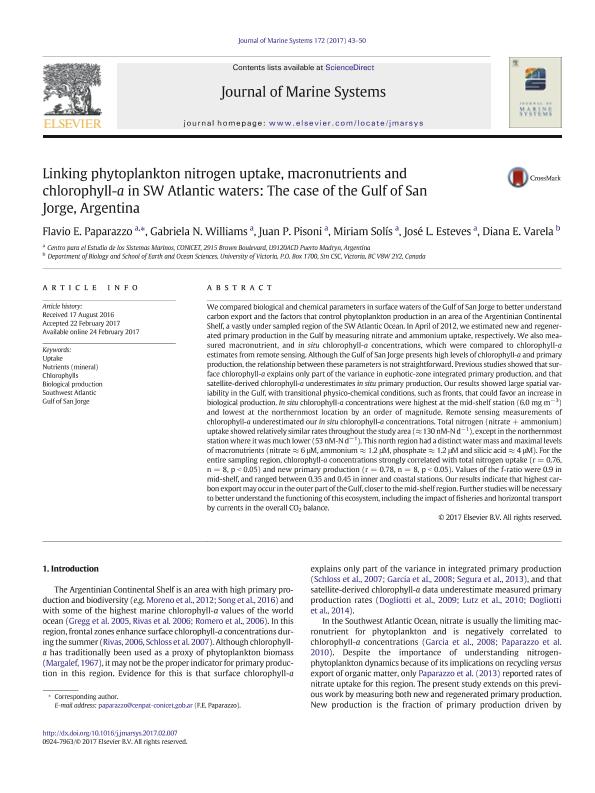Mostrar el registro sencillo del ítem
dc.contributor.author
Paparazzo, Flavio Emiliano

dc.contributor.author
Williams, Gabriela Noemí

dc.contributor.author
Pisoni, Juan Pablo

dc.contributor.author
Solis, Miriam Edith

dc.contributor.author
Esteves, Jose Luis

dc.contributor.author
Varela, Diana E.
dc.date.available
2017-09-22T18:36:10Z
dc.date.issued
2016-12
dc.identifier.citation
Paparazzo, Flavio Emiliano; Williams, Gabriela Noemí; Pisoni, Juan Pablo; Solis, Miriam Edith; Esteves, Jose Luis; et al.; Linking phytoplankton nitrogen uptake, macronutrients and chlorophyll-a in SW Atlantic waters: The case of the Gulf of San Jorge, Argentina; Elsevier Science; Journal Of Marine Systems; 172; 12-2016; 43-50
dc.identifier.issn
0924-7963
dc.identifier.uri
http://hdl.handle.net/11336/24950
dc.description.abstract
We compared biological and chemical parameters in surface waters of the Gulf of San Jorge to better understand carbon export and the factors that control phytoplankton production in an area of the Argentinian Continental Shelf, a vastly under sampled region of the SW Atlantic Ocean. In April of 2012, we estimated new and regenerated primary production in the Gulf by measuring nitrate and ammonium uptake, respectively. We also measured macronutrient, and in situ chlorophyll-a concentrations, which were compared to chlorophyll-a estimates from remote sensing. Although the Gulf of San Jorge presents high levels of chlorophyll-a and primary production, the relationship between these parameters is not straightforward. Previous studies showed that surface chlorophyll-a explains only part of the variance in euphotic-zone integrated primary production, and that satellite-derived chlorophyll-a underestimates in situ primary production. Our results showed large spatial variability in the Gulf, with transitional physico-chemical conditions, such as fronts, that could favor an increase in biological production. In situ chlorophyll-a concentrations were highest at the mid-shelf station (6.0 mg m−3 ) and lowest at the northernmost location by an order of magnitude. Remote sensing measurements of chlorophyll-a underestimated our in situ chlorophyll-a concentrations. Total nitrogen (nitrate + ammonium) uptake showed relatively similar rates throughout the study area (≈130 nM-N d−1 ), except in the northernmost station where it was much lower (53 nM-N d−1 ). This north region had a distinct water mass and maximal levels of macronutrients (nitrate ≈ 6 μM, ammonium ≈ 1.2 μM, phosphate ≈ 1.2 μM and silicic acid ≈ 4 μM). For the entire sampling region, chlorophyll-a concentrations strongly correlated with total nitrogen uptake (r = 0.76, n = 8, p b 0.05) and new primary production (r = 0.78, n = 8, p b 0.05). Values of the f-ratio were 0.9 in mid-shelf, and ranged between 0.35 and 0.45 in inner and coastal stations. Our results indicate that highest carbon export may occur in the outer part of the Gulf, closer to the mid-shelf region. Further studies will be necessary to better understand the functioning of this ecosystem, including the impact of fisheries and horizontal transport by currents in the overall CO2 balance.
dc.format
application/pdf
dc.language.iso
eng
dc.publisher
Elsevier Science

dc.rights
info:eu-repo/semantics/openAccess
dc.rights.uri
https://creativecommons.org/licenses/by-nc-sa/2.5/ar/
dc.subject
Uptake
dc.subject
Nutrients (Mineral)
dc.subject
Clorophylls
dc.subject
Biological Production
dc.subject
Southwest Atlantic
dc.subject
Gulf of San Jorge
dc.subject.classification
Oceanografía, Hidrología, Recursos Hídricos

dc.subject.classification
Ciencias de la Tierra y relacionadas con el Medio Ambiente

dc.subject.classification
CIENCIAS NATURALES Y EXACTAS

dc.title
Linking phytoplankton nitrogen uptake, macronutrients and chlorophyll-a in SW Atlantic waters: The case of the Gulf of San Jorge, Argentina
dc.type
info:eu-repo/semantics/article
dc.type
info:ar-repo/semantics/artículo
dc.type
info:eu-repo/semantics/publishedVersion
dc.date.updated
2017-06-30T13:28:59Z
dc.journal.volume
172
dc.journal.pagination
43-50
dc.journal.pais
Países Bajos

dc.journal.ciudad
Amsterdam
dc.description.fil
Fil: Paparazzo, Flavio Emiliano. Consejo Nacional de Investigaciones Científicas y Técnicas. Centro Científico Tecnológico Conicet - Centro Nacional Patagónico. Centro para el Estudio de Sistemas Marinos; Argentina
dc.description.fil
Fil: Williams, Gabriela Noemí. Consejo Nacional de Investigaciones Científicas y Técnicas. Centro Científico Tecnológico Conicet - Centro Nacional Patagónico. Centro para el Estudio de Sistemas Marinos; Argentina
dc.description.fil
Fil: Pisoni, Juan Pablo. Consejo Nacional de Investigaciones Científicas y Técnicas. Centro Científico Tecnológico Conicet - Centro Nacional Patagónico. Centro para el Estudio de Sistemas Marinos; Argentina
dc.description.fil
Fil: Solis, Miriam Edith. Consejo Nacional de Investigaciones Científicas y Técnicas. Centro Científico Tecnológico Conicet - Centro Nacional Patagónico. Centro para el Estudio de Sistemas Marinos; Argentina
dc.description.fil
Fil: Esteves, Jose Luis. Consejo Nacional de Investigaciones Científicas y Técnicas. Centro Científico Tecnológico Conicet - Centro Nacional Patagónico. Centro para el Estudio de Sistemas Marinos; Argentina
dc.description.fil
Fil: Varela, Diana E.. University Of Victoria; Canadá
dc.journal.title
Journal Of Marine Systems

dc.relation.alternativeid
info:eu-repo/semantics/altIdentifier/url/http://www.sciencedirect.com/science/article/pii/S0924796316302494
dc.relation.alternativeid
info:eu-repo/semantics/altIdentifier/doi/http://dx.doi.org/10.1016/j.jmarsys.2017.02.007
Archivos asociados
